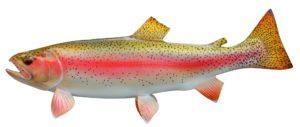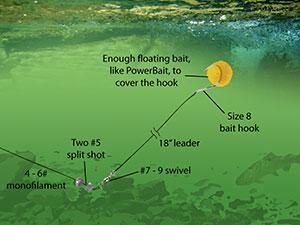Fishing techniques for lakes and ponds

There are lots (and lots) of ways to fish for trout, but three of the easiest ways to fish for trout in lakes and ponds are:
- Suspending bait under a bobber. Start with a piece of worm or a little PowerBait or similar product on a bait hook. Attach a small, lead weight just above the hook to help the bait sink, and add a bobber 1 ½ to 3 feet above the hook. Cast out to a likely spot and wait for the bobber to wiggle, dive or jerk. This is a good technique when fish are cruising nearer the surface or when you want to keep your bait and hook suspended above a weed bed.
- Fishing with bait off the bottom. Sometimes trout are in deeper water and the bait needs to be down deep where the fish are. In this technique there is no bobber to suspend the bait. Instead the lead weight is attached about 1 ½ feet above the baited hook and cast out. The lead weight will sink, but the bait will float up and hover 1 ½ feet above the bottom of the lake.
- Retrieving a spinner, spoon or fly. Spinners mimic small minnows, leeches and other favorite trout food. When fishing a spinner or spoon, cast it over trout-habitat-looking water. Let it sink for a minute then begin reeling it in (retrieving). Vary the amount of time you let the spinner sink and the speed of the retrieve until you find the combination that catches fish.
Fishing techniques for rivers and streams
In moving water it is the current, instead of your retrieve, that will affect how your lure moves in the water. Some good trout fishing techniques for moving waters include:
- Casting a spinner or spoon. Begin by casting the spinner slightly upriver and reel in any slack line.
- As the current carries the spinner down river, hold as much fishing line off the water as you can to achieve a natural “drift.” Once the spinner has swung toward the shore and is straight down river, begin a moderate retrieve.
- Drifting a worm or an artificial bait (PowerBait, for example) with enough split shot to get within a few inches of the bottom. Sometimes adding a bobber will help keep track of where the bait is drifting.
- NOTE: Where a river slows and deepens into a pool with very little current, you can use many of the same trout fishing techniques you would use in a small pond or other still water.





nockedup Massachusetts outdoors.